Today I happened to be looking back in one of my old diaries, and discovered an entry about something I had completely forgotten.
September 26, 1979: Today I played my first game with a chess calculator, which is owned by a guy named Robin whom I know. I am very unimpressed. That is, I am impressed that a little box can play chess in a semi-rational way, but on a human level it plays really badly. I set it on the “average” level and won blindfold in 14 moves.
Let’s look at the game, shall we?
Dana Mackenzie vs. Chess Calculator, 1979
(Sorry, I don’t know what brand it was. This was before the days when everybody had a chess program on their personal computer. In fact, it was in the days before everybody had a personal computer. Not only that, it was before anybody had a personal computer. Does that tell you how old I am or what?)
1. e4 Nf6 2. e5 Ne4 3. Nc3 Nxc3 4. bc Nc6
The machine has apparently been programmed to bring out knights before bishops. Knights before anything, in fact.
5. d4 g6 6. Nf3 Na5 7. d5 b6 8. Bb5 h6? 9. O-O Bb7? 10. e6 …
Okay, although I was playing blindfold I won’t make you go over it blindfold. Besides, I want to talk about this position later.
FEN: r2qkb1r/pbpppp2/1p2P1pp/nB1P4/8/2P2N2/P1P2PPP/R1BQ1RK1 b kq – 0 10
So far the chess calculator’s strategy reminds me a bit of some of the kids at the Aptos Chess Club who believe that because the king and queen are their most valuable pieces, they should keep those pieces at home and never, under any circumstances, move their d- and e-pawns.
But chess is a funny game. Sometimes you can get away with a lot of so-called bad moves. When I was playing over the game this afternoon, I started wondering what would have happened if Black had played the best move here, 10. … c6. It certainly seems as if White ought to be winning, but it’s not so easy to prove that fact, and it leads to some amazing variations.
Instead, the chess calculator helped me out. It played … c6, but only after an intermediate move that made everything much easier for me.
10. … fe? 11. de c6 12. Ne5! Qc7
Here in my diary I commented that 12. … d6 would have been met by 13. Qf3! Rh7 14. Qf7+! Rxf7 15. ef mate. This deserves a diagram:
Sacrificing a queen, checkmating with a pawn. Ho-hum. Just another day at the office. Instead, after 12. … Qc7, I checkmated in two with 13. ed+ Kd8 14. Nf7 mate.
Okay, so now let’s back up to the first diagram and ask what White would have played if Black had played the more pugnacious 10. … c6?
Well, there are lots of good-looking moves, but certainly the one I would start with (and the one the computer was presumably afraid of) is 11. ef+ Kxf7 12. Ne5+, flushing the king out into the open. Black has two reasonable options: 12. … Kg7 0r 12. … Kg8. Let’s look at 12. … Kg7 first.
FEN: r2q1b1r/pb1pp1k1/1pp3pp/nB1PN3/8/2P5/P1P2PPP/R1BQ1RK1 w – – 0 13
What should White do here? You could try the flashy sacrifice 13. Nxg6, but I think it leads to nothing much after 13. … cb 14. Nxh8 Kxh8. White has given away two of his best attackers, and now there is not much of an attack left.
I think this is one of those “retreat to win” situations where White should simply say okay, my bishop is under attack and I need it for my kingside attack. So I should just play 13. Bd3! Notice that on any routine move for Black, such as 13. … cd, 14. Qf3! is just lights out. (If 14. … Qe8 15. Bxg6.) So Black really has to evict White’s knight with 13. … d6. But White just presses on relentlessly with 14. Qg4!, and Black cannot stop the bleeding on the light squares. Once again, if 14. … Qe8 then 15. Bxg6.
Okay, so that was pretty easy. So let’s back up and ask what if Black had played 12. … Kg8 instead. (Just move the g7 king to g8 in the last diagram.)
By analogy with the last line, 13. Bd3! makes a lot of sense. As before, the monster threat is to play 14. Qf3. However, in this position Black has another defense that makes things a little bit more difficult: 13. … Bg7.
FEN: r2q2kr/pb1pp1b1/1pp3pp/n2PN3/8/2PB4/P1P2PPP/R1BQ1RK1 w – – 0 14
With the knight hanging, 14. Nxg6 looks like the logical move to me. Now 14. … Rh7 may be the best move for Black, just conceding the pawn, but because I’m writing this just for fun, I want to show you what happens if Black decides to go down swinging with 14. … Bxc3 15. Nxh8! Bxa1.
FEN: r2q2kN/pb1pp3/1pp4p/n2P4/8/3B4/P1P2PPP/b1BQ1RK1 w – – 0 16
It’s starting to look as if White might have gone wrong here. Material is even, the knight is hanging, the pawn on d5 is hanging, and the kingside attack is still a little bit nebulous. As long as Black controls the dark squares, it’s not all that clear how White is going to checkmate Black.
Nevertheless, White has a great move here! Do you see what it is?
(Space inserted to give you a chance to think.)
The answer is 16. Bxh6!! A prodigious move! This is what I would call a passive knight sacrifice — White sacrifices the knight by just leaving it there. The amazing point is that Black can’t take it either way. If 16. … Kxh8 White plays 17. Qxa1+ (the longest possible check on the board!) followed by Qg7 mate. If 16. … Bxh8 the Bishop takes away the king’s best flight square, so 17. Qg4+ Kf7 18. Qg6 is mate.
But we’re not done yet! Suppose that Black sees through White’s wily scheme and plays 16. … Bf6. (Other bishop moves are no better.) Then White could get his knight out of trouble with 17. Ng6, but what’s the fun in that? Black could then play 17. … cd. Material would be even, and though I would rather be White, there’s still work to do.
Instead let’s have fun and play 17. Qg4+! White says, “No, no, I insist! You really must take my knight!” Black sighs (if a calculator can sigh) and plays 17. … Kxh8. Now do you see White’s winning move?
FEN: r2q3k/pb1pp3/1pp2b1B/n2P4/6Q1/3B4/P1P2PPP/5RK1 w – – 0 18
Well, let’s think about it logically. White really wants to play 18. Qg6, but the trouble is that Black can defend the mate with 18. … Qg8. And now if 19. Qh5, threatening discovered check, Black has the resource 19. … Qxd5! White can still play a discovered check with 20. Bg5+, but it’s a mess. I don’t see any forced mates.
So the winning idea is to block the queen’s path with 18. Bf8!! The simple threat is to play 19. Qg6 next move. I believe that chess problemists call this “interference.” If Black takes the bishop, with 18. … Qxf8, then after 19. Qh5+ he either has to give up the queen or walk into an epaulettes mate with 19. … Kg7 20. Qh7 mate. And even giving up the queen only puts the mate off a few moves: 19. … Qh6 20. Qxh6+ Kg8 21. Bh7+ Kf7 22. Qg6+ Kf8 23. Qg8 mate.
But once again Black can be clever, and instead of taking the bishop he can play 18. … Qe8 to keep White’s queen out of g6 (or h5). Then 19. Bg6 forces Black to give up the queen. After 19. … Qxg6 20. Qxg6 Rxf8 we get to a position where it looks at first as if Black might have a chance, because he has won three pieces for the queen. However, White can snuff out Black’s hopes with 21. Re1!
FEN: 5r1k/pb1pp3/1pp2bQ1/n2P4/8/8/P1P2PPP/4R1K1 b – – 0 21
The threat is slow but brutal: Re1-e3-h3 with mate, and Black can do nothing to stop it. Bishop moves such as 21. … Bd4 or 21. … Bg7 run into 22. Rxe7. The knight’s belated attempt to enter the game with 21. … Nc4 simply loses the knight to 22. Qh5+ followed by 23. Qg4+. (Black could soldier on with two pieces against the queen, but in the long run his game is hopeless.)
Chess never ceases to amaze me. Who would think that in a basically ridiculous game like this one, you could nevertheless find such beauty? Of course, this discussion is all academic. The primitive calculator had no idea what it was doing. And if by chance it had played 10. … c6, I’m sure that (playing blindfold) I could never have found all these extravagant brilliancies.
On the other hand, you’ve seen some great tactical ideas in this post. “Retreat to win,” conserving your attacking pieces so that you’ll have mating material, passive piece sacrifices, interference sacrifices, sacrifices to seal off the king’s flight squares, and just about every mating pattern with a queen and a bishop. A veritable cornucopia of tactics!
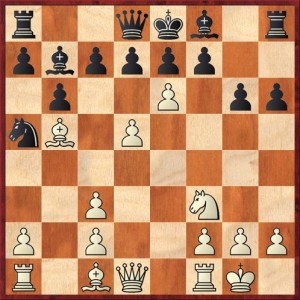
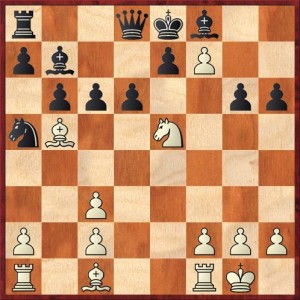
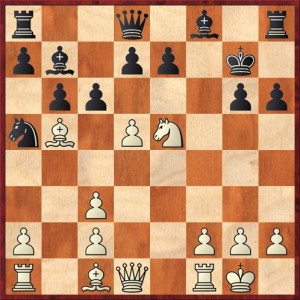
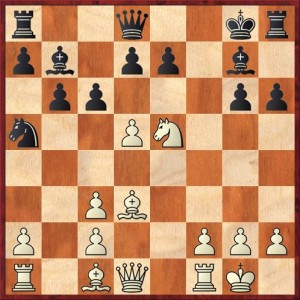
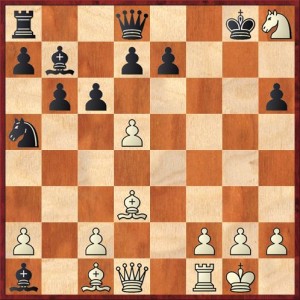
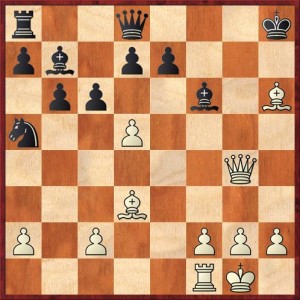
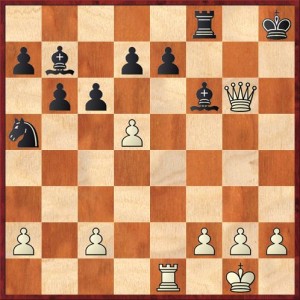



{ 4 comments… read them below or add one }
In the analysis line after …Kxh8, Bg7+ looks like a simpler win.
Do you think so? I couldn’t see a clear way to break through Black’s dark-square defense after 18. Bg7+ Bxg7 19. Qh5+ (or Qg6) Kg8. Black’s bishop can shuttle between g7 and f6 to keep White’s queen away from potential mating squares. Probably there is a win for White with f4-f5-f6 or something, but this seemed frustratingly indirect, so I started looking for another option. That’s when I hit upon the paradoxical move 18. Bf8!, which seemingly threatens nothing but actually throws a monkey wrench into all Black’s defenses.
Unless Black notices …Bxg7, that is.
Oh, I thought that you were suggesting 18. Bg7+ as an alternative way of sacrificing the bishop. Let’s just pretend that was your intention!
{ 1 trackback }